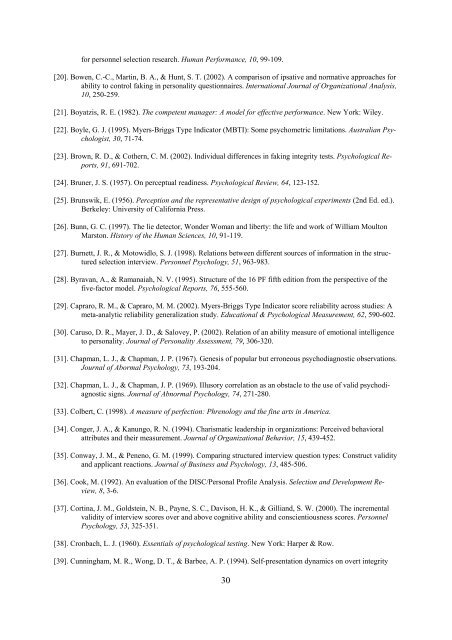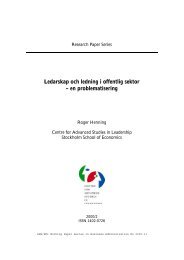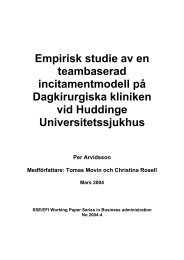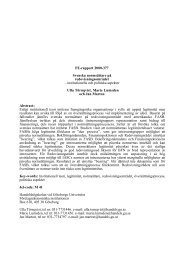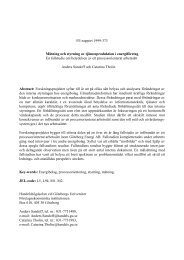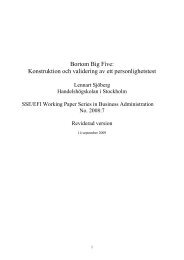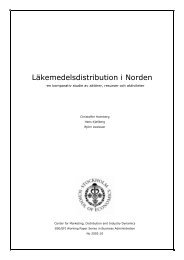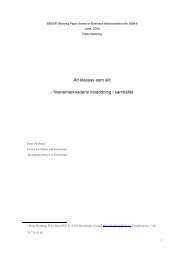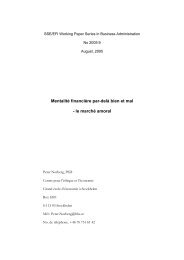personlighetstest i arbetslivet: historik och aktuell forskning
personlighetstest i arbetslivet: historik och aktuell forskning
personlighetstest i arbetslivet: historik och aktuell forskning
Create successful ePaper yourself
Turn your PDF publications into a flip-book with our unique Google optimized e-Paper software.
for personnel selection research. Human Performance, 10, 99-109.<br />
[20]. Bowen, C.-C., Martin, B. A., & Hunt, S. T. (2002). A comparison of ipsative and normative approaches for<br />
ability to control faking in personality questionnaires. International Journal of Organizational Analysis,<br />
10, 250-259.<br />
[21]. Boyatzis, R. E. (1982). The competent manager: A model for effective performance. New York: Wiley.<br />
[22]. Boyle, G. J. (1995). Myers-Briggs Type Indicator (MBTI): Some psychometric limitations. Australian Psychologist,<br />
30, 71-74.<br />
[23]. Brown, R. D., & Cothern, C. M. (2002). Individual differences in faking integrity tests. Psychological Reports,<br />
91, 691-702.<br />
[24]. Bruner, J. S. (1957). On perceptual readiness. Psychological Review, 64, 123-152.<br />
[25]. Brunswik, E. (1956). Perception and the representative design of psychological experiments (2nd Ed. ed.).<br />
Berkeley: University of California Press.<br />
[26]. Bunn, G. C. (1997). The lie detector, Wonder Woman and liberty: the life and work of William Moulton<br />
Marston. History of the Human Sciences, 10, 91-119.<br />
[27]. Burnett, J. R., & Motowidlo, S. J. (1998). Relations between different sources of information in the structured<br />
selection interview. Personnel Psychology, 51, 963-983.<br />
[28]. Byravan, A., & Ramanaiah, N. V. (1995). Structure of the 16 PF fifth edition from the perspective of the<br />
five-factor model. Psychological Reports, 76, 555-560.<br />
[29]. Capraro, R. M., & Capraro, M. M. (2002). Myers-Briggs Type Indicator score reliability across studies: A<br />
meta-analytic reliability generalization study. Educational & Psychological Measurement, 62, 590-602.<br />
[30]. Caruso, D. R., Mayer, J. D., & Salovey, P. (2002). Relation of an ability measure of emotional intelligence<br />
to personality. Journal of Personality Assessment, 79, 306-320.<br />
[31]. Chapman, L. J., & Chapman, J. P. (1967). Genesis of popular but erroneous psychodiagnostic observations.<br />
Journal of Abormal Psychology, 73, 193-204.<br />
[32]. Chapman, L. J., & Chapman, J. P. (1969). Illusory correlation as an obstacle to the use of valid psychodiagnostic<br />
signs. Journal of Abnormal Psychology, 74, 271-280.<br />
[33]. Colbert, C. (1998). A measure of perfection: Phrenology and the fine arts in America.<br />
[34]. Conger, J. A., & Kanungo, R. N. (1994). Charismatic leadership in organizations: Perceived behavioral<br />
attributes and their measurement. Journal of Organizational Behavior, 15, 439-452.<br />
[35]. Conway, J. M., & Peneno, G. M. (1999). Comparing structured interview question types: Construct validity<br />
and applicant reactions. Journal of Business and Psychology, 13, 485-506.<br />
[36]. Cook, M. (1992). An evaluation of the DISC/Personal Profile Analysis. Selection and Development Review,<br />
8, 3-6.<br />
[37]. Cortina, J. M., Goldstein, N. B., Payne, S. C., Davison, H. K., & Gilliand, S. W. (2000). The incremental<br />
validity of interview scores over and above cognitive ability and conscientiousness scores. Personnel<br />
Psychology, 53, 325-351.<br />
[38]. Cronbach, L. J. (1960). Essentials of psychological testing. New York: Harper & Row.<br />
[39]. Cunningham, M. R., Wong, D. T., & Barbee, A. P. (1994). Self-presentation dynamics on overt integrity<br />
30


